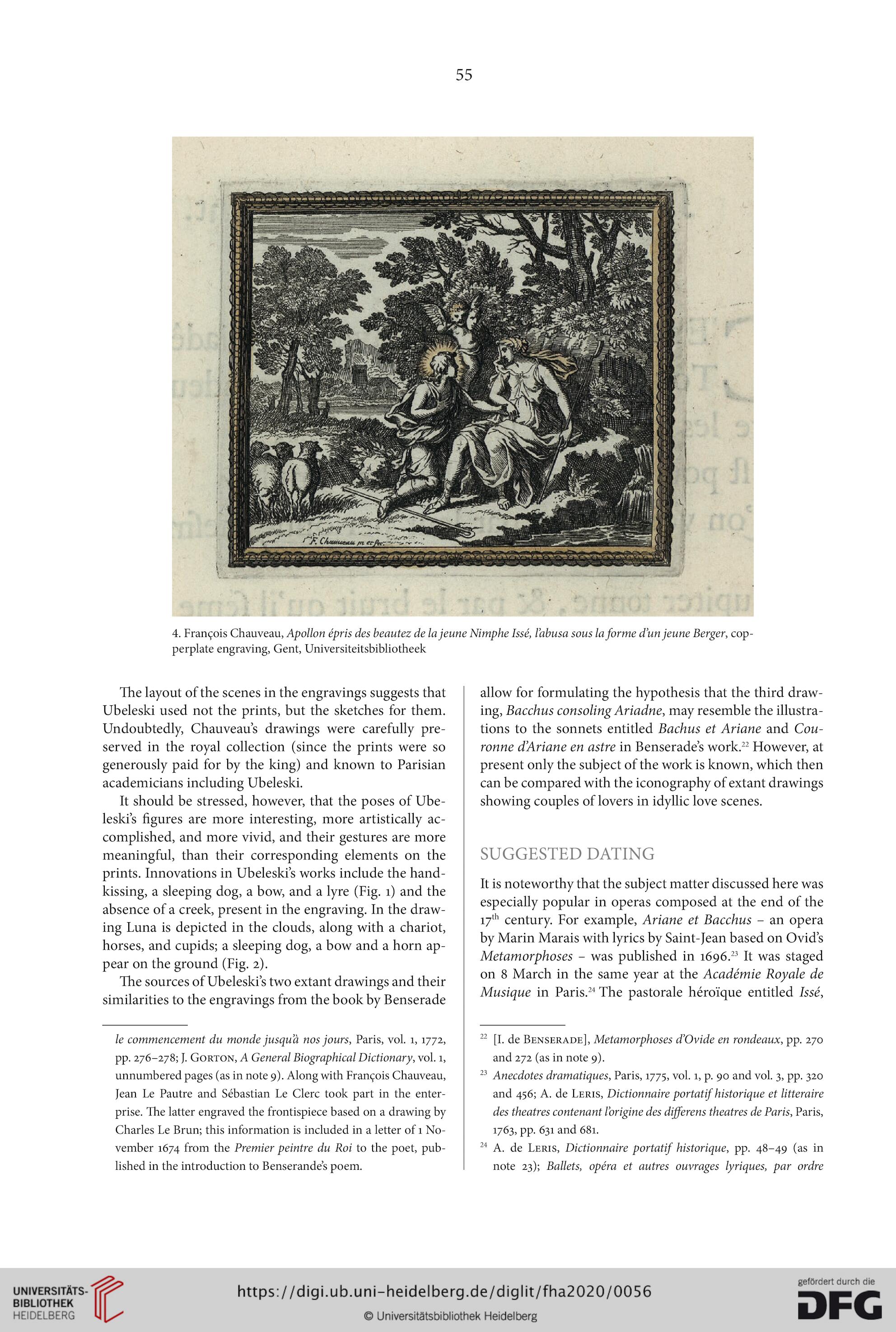55
4. François Chauveau, Apollon épris des beautez de la jeune Nimphe Issé, l’abusa sous la forme d’un jeune Berger, cop-
perplate engraving, Gent, Universiteitsbibliotheek
The layout of the scenes in the engravings suggests that
Ubeleski used not the prints, but the sketches for them.
Undoubtedly, Chauveaus drawings were carefully pre-
served in the royal collection (since the prints were so
generously paid for by the king) and known to Parisian
academicians including Ubeleski.
It should be stressed, however, that the poses of Ube-
leskis figures are more interesting, more artistically ac-
complished, and more vivid, and their gestures are more
meaningful, than their corresponding elements on the
prints. Innovations in Ubeleskis works include the hand-
kissing, a sleeping dog, a bow, and a lyre (Fig. 1) and the
absence of a creek, present in the engraving. In the draw-
ing Luna is depicted in the clouds, along with a chariot,
horses, and cupids; a sleeping dog, a bow and a horn ap-
pear on the ground (Fig. 2).
The sources of Ubeleskis two extant drawings and their
similarities to the engravings from the book by Benserade
le commencement du monde jusqu’à nos jours, Paris, vol. 1, 1772,
pp. 276-278; J. Gorton, A General Biographical Dictionary, vol. 1,
unnumbered pages (as in note 9). Along with François Chauveau,
Jean Le Pautre and Sébastian Le Clerc took part in the enter-
prise. The latter engraved the frontispiece based on a drawing by
Charles Le Brun; this information is included in a letter of 1 No-
vember 1674 from the Premier peintre du Roi to the poet, pub-
lished in the introduction to Benserandes poem.
allow for formulating the hypothesis that the third draw-
ing, Bacchus consoling Ariadne, may resemble the illustra-
tions to the sonnets entitled Bachus et Ariane and Cou-
ronne d’Ariane en astre in Benserades work.22 However, at
present only the subject of the work is known, which then
can be compared with the iconography of extant drawings
showing couples of lovers in idyllic love scenes.
SUGGESTED DATING
It is noteworthy that the subject matter discussed here was
especially popular in operas composed at the end of the
17th century. For example, Ariane et Bacchus - an opera
by Marin Marais with lyrics by Saint-Jean based on Ovid s
Metamorphoses - was published in 1696.23 It was staged
on 8 March in the same year at the Académie Royale de
Musique in Paris.24 The pastorale héroïque entitled Issé,
22 [I. de Benserade], Metamorphoses d’Ovide en rondeaux, pp. 270
and 272 (as in note 9).
23 Anecdotes dramatiques, Paris, 1775, vol. 1, p. 90 and vol. 3, pp. 320
and 456; A. de Leris, Dictionnaire portatif historique et litteraire
des theatres contenant l’origine des differens theatres de Paris, Paris,
1763, pp. 631 and 681.
24 A. de Leris, Dictionnaire portatif historique, pp. 48-49 (as in
note 23); Ballets, opéra et autres ouvrages lyriques, par ordre
4. François Chauveau, Apollon épris des beautez de la jeune Nimphe Issé, l’abusa sous la forme d’un jeune Berger, cop-
perplate engraving, Gent, Universiteitsbibliotheek
The layout of the scenes in the engravings suggests that
Ubeleski used not the prints, but the sketches for them.
Undoubtedly, Chauveaus drawings were carefully pre-
served in the royal collection (since the prints were so
generously paid for by the king) and known to Parisian
academicians including Ubeleski.
It should be stressed, however, that the poses of Ube-
leskis figures are more interesting, more artistically ac-
complished, and more vivid, and their gestures are more
meaningful, than their corresponding elements on the
prints. Innovations in Ubeleskis works include the hand-
kissing, a sleeping dog, a bow, and a lyre (Fig. 1) and the
absence of a creek, present in the engraving. In the draw-
ing Luna is depicted in the clouds, along with a chariot,
horses, and cupids; a sleeping dog, a bow and a horn ap-
pear on the ground (Fig. 2).
The sources of Ubeleskis two extant drawings and their
similarities to the engravings from the book by Benserade
le commencement du monde jusqu’à nos jours, Paris, vol. 1, 1772,
pp. 276-278; J. Gorton, A General Biographical Dictionary, vol. 1,
unnumbered pages (as in note 9). Along with François Chauveau,
Jean Le Pautre and Sébastian Le Clerc took part in the enter-
prise. The latter engraved the frontispiece based on a drawing by
Charles Le Brun; this information is included in a letter of 1 No-
vember 1674 from the Premier peintre du Roi to the poet, pub-
lished in the introduction to Benserandes poem.
allow for formulating the hypothesis that the third draw-
ing, Bacchus consoling Ariadne, may resemble the illustra-
tions to the sonnets entitled Bachus et Ariane and Cou-
ronne d’Ariane en astre in Benserades work.22 However, at
present only the subject of the work is known, which then
can be compared with the iconography of extant drawings
showing couples of lovers in idyllic love scenes.
SUGGESTED DATING
It is noteworthy that the subject matter discussed here was
especially popular in operas composed at the end of the
17th century. For example, Ariane et Bacchus - an opera
by Marin Marais with lyrics by Saint-Jean based on Ovid s
Metamorphoses - was published in 1696.23 It was staged
on 8 March in the same year at the Académie Royale de
Musique in Paris.24 The pastorale héroïque entitled Issé,
22 [I. de Benserade], Metamorphoses d’Ovide en rondeaux, pp. 270
and 272 (as in note 9).
23 Anecdotes dramatiques, Paris, 1775, vol. 1, p. 90 and vol. 3, pp. 320
and 456; A. de Leris, Dictionnaire portatif historique et litteraire
des theatres contenant l’origine des differens theatres de Paris, Paris,
1763, pp. 631 and 681.
24 A. de Leris, Dictionnaire portatif historique, pp. 48-49 (as in
note 23); Ballets, opéra et autres ouvrages lyriques, par ordre




